Introduction
The following essay is analyses the beer industry in the United States. It looks into the beer industry and what can be done to ensure that the beer it develops an appropriate growth mechanism in the light of globalization, integrated technology and strict industry regulations.
The analysis looks into the political environmental, social, technological, economic and legal factors that affect the beer industry in the United States.
The Political/Legal Factors
In the year 1940 the prohibition era was over but alcohol did not have wide acceptance among the potential consumers (Lundström 2005). Even after it was made legal by the federal government, the state government perpetuated prohibition by limiting the hours of drinking and distribution systems of beer to make the Americans accept beer as good drink.
The political environment includes taxation procedures that are in the country. Currently, the tax is 40% of the retail prices, which is a higher rate of taxation compared with taxation in other countries such as Germany (Lundström 2005). The imported beer sales volume is at par with the locally produced beer in United States (Figure 1).
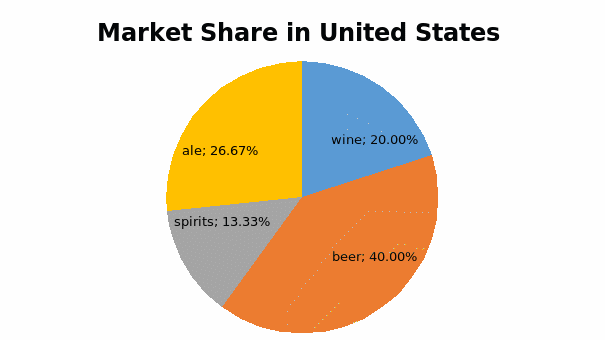
Regulation of the beer industry has also affected its profit margins due to regulation on advertising, as it is perceived to be deceptive to public on the advantages of drinking beer (Strokes 2010).
The Economic Factors
United States of America is the world’s largest economy. It boasts of having the world’s highest gross domestic product as well as highest per capita income of $48,000. The country has a population of approximately 300,000 million people. It is the largest exporter of electronics and technological goods such as computers as well as organic waste (The World Bank 2010).
The first economic aspect that has affected the beer industry is the global recession, which has reduced the volume of beer consumption in the country. The other economic factor relates to the increased competition across the globe due to the merger and acquisition of the beer companies resulting to concentration of beer industries (Figure 2).
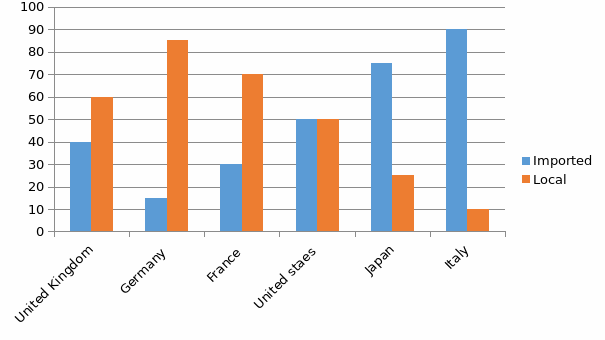
For instance, the United Distillers, one of the major importers of beer in the United States has acquired more than forty establishments of beer distribution in the United States (Espey 1989).
Social Cultural Factors
Americans have a high sense of style and self-importance and everything that helps them to perpetuate this image has a wide acceptance (Strokes 2010). This explains how Heinemann has managed to sell its classic drinks in the United States successfully.
In a survey conducted by the Institute of Beer Manufacturers, it showed that sixty percent of those who drink beer are between eighteen and forty-five years of age (Table 1). It also indicated that beer drinking exists in all social economic classes although it was low among people with $50,000 per capita income (Espey 1989).
Table 1. Estimated Number of Beer Establishments
To understand the culture better, the existing literature especially fictional works indicates instances where the characters were in a binge and the types of beer that they drunk (Swedberg 2009). The social-cultural environment in the United States of America shows prevalence of drinking beer in the country. It also provides information on how beer marketers can capitalise on this market (Andriani et al. 2004).
Technological Factors
Technology has affected the beer industry in the United States in a number of ways. The first way involves the methods of beer production. With increased technology especially the development of enterprise resources planning systems beer industries have increased (Figure 3).
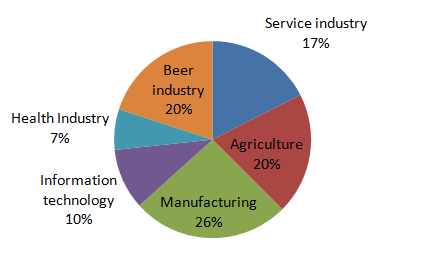
The companies have reduced their costs of operations and managed to reduce the selling price. The use of Enterprise Resource Planning has enabled the companies to reduce administrative costs such as payroll processing to pay the workers, supplier management and inventory management (Schultz 2000).
Technology is also useful in fermenting, processing and eventual production of beer and this has significantly reduced costs of production. Technology has also been useful in marketing the beer products all over the globe through the traditional media such as the television as well as the social networks. The ability to integrate technology in marketing and production activities gives the companies advantage over their competitors (Pratesi 1994).
The Environmental and Ecological Factors
Beer is made from fermented food materials such as rice, corn and barley. With the increased global climatic changes, the demand for food has increased and led to increase in the prices of these commodities. This has made the production costs of beer to be high (Table 2).
Table 2. Estimated Number of Employees
The environment advocacy groups advocate for companies to be energy and environment-conscious. Most of the companies have also engaged or used their resources in environment conservation efforts (Beverage World 2000).
The other environmental factor relates to the increase in lifestyle-related diseases in the United States of America where many people suffer from obesity, diabetes, blood pressure and kidney ailments.
These ailments have made people more conscious and reserved from enjoying alcoholic beverages due to their contribution on the diseases. This has affected the companies negatively as it has reduced the overall number of beer consumers in the country (Lundström 2005).
Buyer Power
The buyers have economic power as the capital consumption of beer in the United States is 121 litres. This shows that beer consumption in the country is not ingrained compared with other European countries like Germany, which has per capita consumption of 140 litres.
The beer industry in the United States contributes approximately $228 billion where $71 billion goes to wages and salaries of those involved in production of beer in the country (The World Bank 2010).
The economic recession, which intensified in the year 2008, has affected buyer power significantly. The unemployment and job losses affected many people negatively. However, the beer industry has not been fully affected mainly because of beer being an addictive substance that people who have a habit of drinking cannot stop doing (Table 1). However, this has affected the sale of classic drinks that have reduced since 2008 (Barnes Reports 2012).
Suppliers
There are two types of suppliers in the United States beer industry. The first type of supplier deal with raw materials such as barley, rice sugar and corn which are the ingredients of beer. Although their supplies are critical they have diminished influence on the industry as they are many and competition among suppliers lowers the prices of this ingredients (Figure 4).
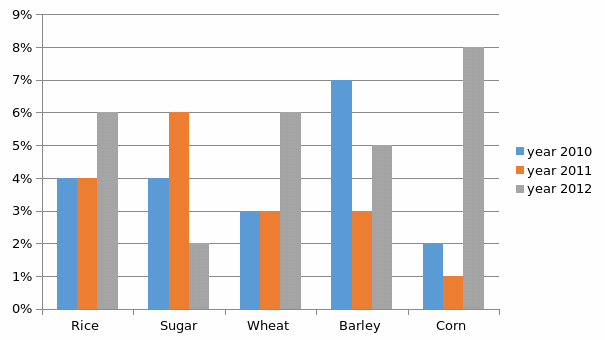
The second class of suppliers who have influence on the beer market are suppliers who supply technology and equipment. They are powerful and they have more influence as technology reduces the cost of production and operations. Therefore, established beer companies establish good relationship with these suppliers to ensure that they are abreast with technological changes that will improve their operations (Barnes Reports 2012).
Globalisation as a political factor has influence on the beer markets in the United States. The liberalisation of markets allowing importation of beer from other countries has led to the entry of variety of beer and alcoholic brands in the country has also reduced the supplier’s influence in the industry.
New Entrants
There are new entrants who have entered the beer market since the year 1990, such as Seagram, Allied and Heinemann that entered the market courtesy of globalisation.
However, there are stringent licensing regulations in the United States that makes it hard for the new entrants (Figure 5). However, with globalisation new entrants come in through takeover by multinationals or mergers with foreign beer companies (Beverage World 2000).
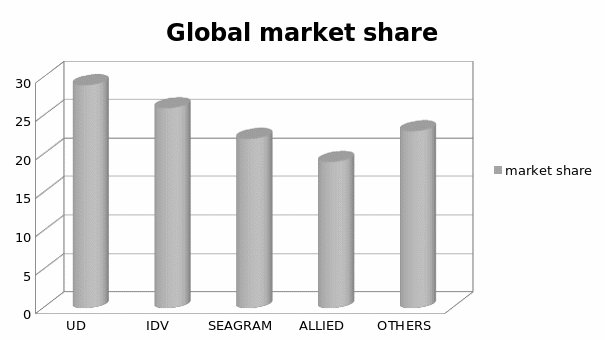
This has hindered creativity in beer industry marketing and advertising due to such regulations. Other regulations pertain to the entry into the industry where the licensing procedures are complicated and designed to lock out new players who want to enter the industry (Lundström 2005).
Substitutes
The main substitutes for beer about alcoholic industry are wines and spirits. However, this can be termed as differentiation rather than substitution. Substitutes such as non-alcoholic drinks have increased their sales especially processed fresh juices.
This is especially due to the health-based marketing, which portrays alcohol as harmful. Pepsi and Coca-Cola have dominated this market of non-alcoholic drinks (Beverage World 2000).
The main substitute is the soft drinks that have competed successfully with the beer industry. Pepsi has been very competitive and its products are consumed in the market.
Rivalry
Rivalry in the industry is fierce due to the need to compete for the market. The competition between the industry players is well displayed through commercials and marketing campaign with each beer company trying to appeal the consumers differently. The rivalry comes through price wars, distributorship and legal actions.
Currently, most of the companies in the industry prefer to use the traditional distribution systems such as retail stores or establishments such as bars and restaurants (Espey 1989).
The future of beer industry in the United States is brighter because of the increased number of beer brands and young consumers. The economic forecasts show that the economy will be out of recession in the year 2014 and this will lead to expansion of the beer industry.
The overall sales volume of beer in the country grew by 4% in the year 2012 (Table 3). Similar growth is expected in the year 2013 and even more growth is expected in the country (Barnes Reports 2012).
Table 3. Five-Year Trend of Sales
Conclusion
The beer industry is one of the greatest industries in America with significant contribution to the economy of the country. Increasing production as well as ensuring that there are factors relating to the development and creation of resources that pertain to the prosperity of country will ensure the development of resources and the issues relating to the expansion of the industry.
References
Andriani, L, Gold, F, Rotella, M, & Scharf, M. 2004, ‘Travels with barley: a journey through beer culture in America’, Emily Publishers Weekly, vol. 8, pp.42.
Barnes Reports 2012, U.S. Beer and ale wholesale industry. Web.
Beverage World 2000, ‘Brew u? Labatt USA opens beer academy’, Beverage World News, 15 May, pp.16.
Espey, J 1989, ‘The big four: an examination of the international drinks industry’, International Journal of Wine Marketing, vol. 1, no. 2, pp.47-64.
Lundström, A. 2005, Beer production policy: theory and practice, Springer, New York.
Pratesi, C 1994, ’Miller beer,’ Management Decision, vol. 32, pp.25-28.
Schultz, M 2000, The expressive organisation: linking identity, reputation and the corporate brand, Oxford University Press, New York.
Strokes, R 2010, E-marketing: the essential guide to online marketing, McGraw Hill, New York.
Swedberg R 2009, Beer: the social science view, Oxford University Press, Oxford.
The World Bank 2010, Doing business 2011: making a difference in beer industry, International Finance Corporation, Washington, D.C.